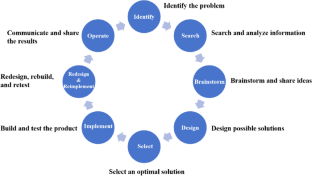Educational Technology Research and Development ( IF 5.580 ) Pub Date : 2024-04-15 , DOI: 10.1007/s11423-024-10377-7 Feifei Xi , Hongliang Ma , Zhongling Pi , Yuhan Dong , Junmei Sun , Rucheng Jin

|
Recently, integrated science, technology, engineering, and mathematics (STEM) education has gained sustained attention in K-12 settings, and engineering design-based pedagogy has become a key issue. Compared with rich research in higher education, relatively few studies are performed on engineering education in K-12 schools. In this study, we combined Conceive-Design-Implement-Operate (CDIO) model with the engineering design process (EDP), naming EDP-CDIO, aiming to promote high school students’ STEM competence and compare its effects with the conventional CDIO approach. A pretest–posttest nonequivalent group design was conducted among 64 eleventh-grade students with eleven lessons. Quantitative data were collected via a pretest and posttest, and qualitative data were collected via artifacts and semistructured interviews. The repeated-measures analysis of variance and epistemic network analysis revealed that, compared with the conventional CDIO approach, the EDP-CDIO model significantly improved students’ STEM knowledge, skills, and attitudes and developed more comprehensive epistemic networks in STEM competence. These findings provide a reference for K-12 STEM teachers, encouraging them to implement the EDP-CDIO model more frequently in the classroom, especially with the iterative design process.
中文翻译:

将工程设计过程融入构思-设计-实施-操作模式,以提升高中生的 STEM 能力
近年来,综合科学、技术、工程和数学(STEM)教育在 K-12 环境中受到持续关注,基于工程设计的教学法已成为一个关键问题。与高等教育领域的丰富研究相比,针对K-12学校工程教育的研究相对较少。在本研究中,我们将构思-设计-实施-操作(CDIO)模式与工程设计过程(EDP)相结合,命名为EDP-CDIO,旨在提升高中生的STEM能力,并与传统CDIO方法进行效果比较。对 64 名十一年级学生进行了预测-后测非等效小组设计,共 11 节课。通过预测试和后测试收集定量数据,通过工件和半结构化访谈收集定性数据。重复测量方差分析和认知网络分析表明,与传统的CDIO方法相比,EDP-CDIO模型显着提高了学生的STEM知识、技能和态度,并在STEM能力中形成了更全面的认知网络。这些发现为K-12 STEM教师提供了参考,鼓励他们在课堂上更频繁地实施EDP-CDIO模型,尤其是迭代设计过程。



























 京公网安备 11010802027423号
京公网安备 11010802027423号